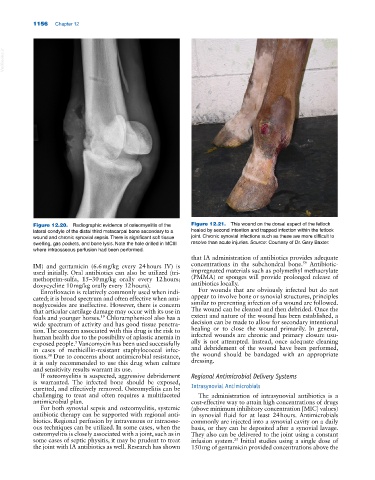Page 1190 - Adams and Stashak's Lameness in Horses, 7th Edition
P. 1190
1156 Chapter 12
VetBooks.ir
Figure 12.20. Radiographic evidence of osteomyelitis of the Figure 12.21. This wound on the dorsal aspect of the fetlock
lateral condyle of the distal third metacarpal bone secondary to a healed by second intention and trapped infection within the fetlock
wound and chronic synovial sepsis. There is significant soft tissue joint. Chronic synovial infections such as these are more difficult to
swelling, gas pockets, and bone lysis. Note the hole drilled in MCIII resolve than acute injuries. Source: Courtesy of Dr. Gary Baxter.
where intraosseous perfusion had been performed.
that IA administration of antibiotics provides adequate
59
IM) and gentamicin (6.6 mg/kg every 24 hours IV) is concentrations in the subchondral bone. Antibiotic‐
used initially. Oral antibiotics can also be utilized (tri impregnated materials such as polymethyl methacrylate
methoprim‐sulfa, 15–30 mg/kg orally every 12 hours; (PMMA) or sponges will provide prolonged release of
doxycycline 10 mg/kg orally every 12 hours). antibiotics locally.
Enrofloxacin is relatively commonly used when indi For wounds that are obviously infected but do not
cated; it is broad spectrum and often effective when ami appear to involve bone or synovial structures, principles
noglycosides are ineffective. However, there is concern similar to preventing infection of a wound are followed.
that articular cartilage damage may occur with its use in The wound can be cleaned and then debrided. Once the
foals and younger horses. Chloramphenicol also has a extent and nature of the wound has been established, a
19
wide spectrum of activity and has good tissue penetra decision can be made to allow for secondary intentional
tion. The concern associated with this drug is the risk to healing or to close the wound primarily. In general,
human health due to the possibility of aplastic anemia in infected wounds are chronic and primary closure usu
5
exposed people. Vancomycin has been used successfully ally is not attempted. Instead, once adequate cleaning
in cases of methicillin‐resistant staphylococcal infec and debridement of the wound have been performed,
38
tions. Due to concerns about antimicrobial resistance, the wound should be bandaged with an appropriate
it is only recommended to use this drug when culture dressing.
and sensitivity results warrant its use.
If osteomyelitis is suspected, aggressive debridement Regional Antimicrobial Delivery Systems
is warranted. The infected bone should be exposed,
curetted, and effectively removed. Osteomyelitis can be Intrasynovial Antimicrobials
challenging to treat and often requires a multifaceted The administration of intrasynovial antibiotics is a
antimicrobial plan. cost‐effective way to attain high concentrations of drugs
For both synovial sepsis and osteomyelitis, systemic (above minimum inhibitory concentration [MIC] values)
antibiotic therapy can be supported with regional anti in synovial fluid for at least 24 hours. Antimicrobials
biotics. Regional perfusion by intravenous or intraosse commonly are injected into a synovial cavity on a daily
ous techniques can be utilized. In some cases, when the basis, or they can be deposited after a synovial lavage.
osteomyelitis is closely associated with a joint, such as in They also can be delivered to the joint using a constant
some cases of septic physitis, it may be prudent to treat infusion system. Initial studies using a single dose of
25
the joint with IA antibiotics as well. Research has shown 150 mg of gentamicin provided concentrations above the

